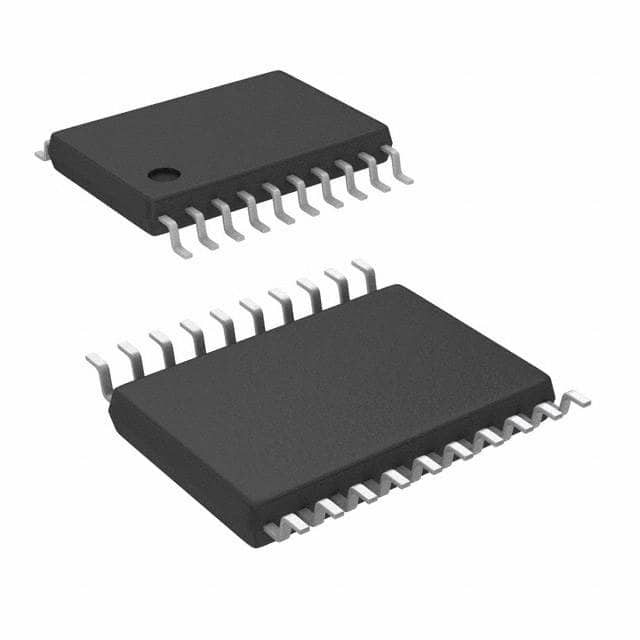Consulte las especificaciones para obtener detalles del producto.

Encyclopedia Entry: 74AC240TTR
Product Overview
- Category: Integrated Circuit (IC)
- Use: Signal Buffer/Line Driver
- Characteristics: High-speed, low-power, octal buffer with 3-state outputs
- Package: TSSOP-20
- Essence: The 74AC240TTR is a versatile integrated circuit that provides buffering and line driving capabilities for digital signals.
- Packaging/Quantity: Available in tape and reel packaging, with 2500 units per reel.
Specifications
- Supply Voltage: 2V to 6V
- Input Voltage: 0V to VCC
- Output Voltage: 0V to VCC
- Operating Temperature Range: -40°C to +85°C
- Propagation Delay: 5.5 ns (typical)
- Output Drive Capability: ±24 mA
Detailed Pin Configuration
The 74AC240TTR IC has a total of 20 pins, which are assigned specific functions as follows:
- A1: Input A1
- Y1: Output Y1
- A2: Input A2
- Y2: Output Y2
- GND: Ground
- A3: Input A3
- Y3: Output Y3
- A4: Input A4
- Y4: Output Y4
- OE: Output Enable
- Y5: Output Y5
- A5: Input A5
- Y6: Output Y6
- A6: Input A6
- Y7: Output Y7
- A7: Input A7
- Y8: Output Y8
- VCC: Supply Voltage
- GND: Ground
- A8: Input A8
Functional Features
- Octal buffer with 3-state outputs
- High-speed operation, suitable for use in fast digital systems
- Low power consumption, making it energy-efficient
- 3-state outputs allow multiple devices to share a common bus without interference
- Schmitt-trigger inputs provide hysteresis and improve noise immunity
Advantages and Disadvantages
Advantages: - High-speed operation enables efficient data transfer - Low power consumption reduces energy usage - 3-state outputs facilitate bus sharing in complex systems - Schmitt-trigger inputs enhance noise immunity
Disadvantages: - Limited output drive capability may not be suitable for high-current applications - Propagation delay of 5.5 ns may introduce timing issues in certain scenarios
Working Principles
The 74AC240TTR is designed as an octal buffer with 3-state outputs. It operates by receiving digital input signals on the A1-A8 pins and providing buffered outputs on the Y1-Y8 pins. The OE (Output Enable) pin controls the 3-state outputs, allowing them to be either active or in a high-impedance state.
When the OE pin is low, the outputs are enabled and actively driven by the internal circuitry. Conversely, when the OE pin is high, the outputs enter a high-impedance state, effectively disconnecting them from the external circuitry.
The Schmitt-trigger inputs ensure that the IC's inputs have hysteresis, which improves noise immunity and provides more reliable signal detection.
Detailed Application Field Plans
The 74AC240TTR is widely used in various digital systems where buffering and line driving capabilities are required. Some common application fields include: - Microprocessor-based systems - Data communication equipment - Industrial automation systems - Automotive electronics - Consumer electronics
Detailed and Complete Alternative Models
- 74HC240: Similar octal buffer with 3-state outputs, compatible with 5V systems
- 74ACT240: Octal buffer with 3-state outputs, designed for faster operation at 5V
- SN74LS240: Octal buffer with 3-state outputs, suitable for use in 5V TTL logic systems
These alternative models offer similar functionality to the 74AC240TTR but may have different voltage compatibility or operating characteristics.
In conclusion, the 74AC240TTR is a versatile integrated circuit that provides high-speed buffering and line driving capabilities. Its low power consumption, 3-state outputs, and Schmitt-trigger inputs make it suitable for various digital applications. However, its limited output drive capability and propagation delay should be considered when selecting this IC for specific projects.
Enumere 10 preguntas y respuestas comunes relacionadas con la aplicación de 74AC240TTR en soluciones técnicas
Sure! Here are 10 common questions and answers related to the application of 74AC240TTR in technical solutions:
Q: What is the 74AC240TTR? A: The 74AC240TTR is a type of octal buffer/line driver integrated circuit (IC) that can be used to amplify and control digital signals.
Q: What is the purpose of using the 74AC240TTR in a technical solution? A: The 74AC240TTR can be used to interface between different logic families, provide signal buffering, and drive loads with higher current capabilities.
Q: What voltage levels does the 74AC240TTR support? A: The 74AC240TTR supports a wide range of voltage levels, typically from 2V to 6V.
Q: How many input/output pins does the 74AC240TTR have? A: The 74AC240TTR has 8 input pins and 8 output pins, making it an octal buffer.
Q: Can the 74AC240TTR handle bidirectional data flow? A: Yes, the 74AC240TTR is designed to support bidirectional data flow, allowing data to be transmitted in both directions.
Q: What is the maximum current that the 74AC240TTR can source or sink? A: The 74AC240TTR can typically source or sink up to 24mA of current per output pin.
Q: Does the 74AC240TTR have any built-in protection features? A: Yes, the 74AC240TTR includes built-in electrostatic discharge (ESD) protection diodes to safeguard against static electricity damage.
Q: Can the 74AC240TTR be cascaded to drive more outputs? A: Yes, multiple 74AC240TTR ICs can be cascaded together to drive a larger number of outputs.
Q: What is the power supply voltage range for the 74AC240TTR? A: The 74AC240TTR typically operates with a power supply voltage range of 2V to 6V.
Q: Are there any specific precautions to consider when using the 74AC240TTR? A: It is important to ensure that the input and output voltages are within the specified range, and to avoid exceeding the maximum current ratings to prevent damage to the IC.
Please note that these answers are general and may vary depending on the specific datasheet and manufacturer's specifications for the 74AC240TTR.

